10 Animals with Self-Awareness
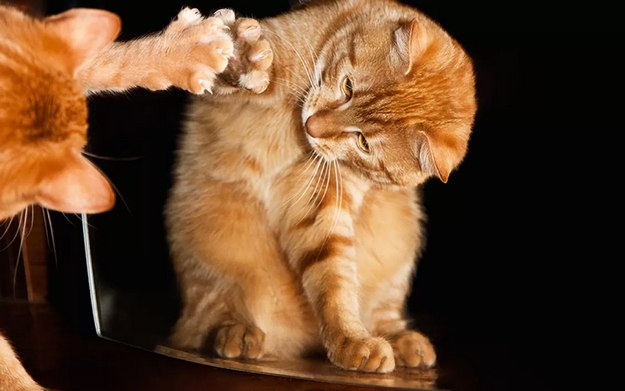
The human mind is amazing, but it's not unique in its capacity for self-awareness. Today, researchers suspect a growing number of animals with self-awareness based on the mirror test, also known as the mark test or mirror self-recognition (MSR). So how does the mirror test work and which animals demonstrate this high functioning cognitive ability?
What is Self-Awareness?
In humans, self-awareness means to have conscious knowledge of our own person as being separate from the world and others. We're able to identify that we have our own thoughts and feelings, which enables us to separate our ego from others and attribute different thoughts and feelings to them.
In the wider animal kingdom, the bar for self-awareness is lowered because it's not possible to measure what animals think and feel. So instead, we look for signs that they recognize they exist separately from other animals and the environment. And the best way to determine this scientifically is with the mirror test.
The Mirror Test
Invented in the 1970s, the mirror or mark test sees an experimenter discreetly mark an animal with a colored dye or sticker on their forehead. The animal is then presented with a mirror and their reaction is observed.
Animals with self-awareness turn and adjust their body to get a better view of the new mark on their body. They may also touch the spot and try to remove it, recognizing that it doesn't belong there. These behaviors show that the animal understands the reflection they see in the mirror is their own.
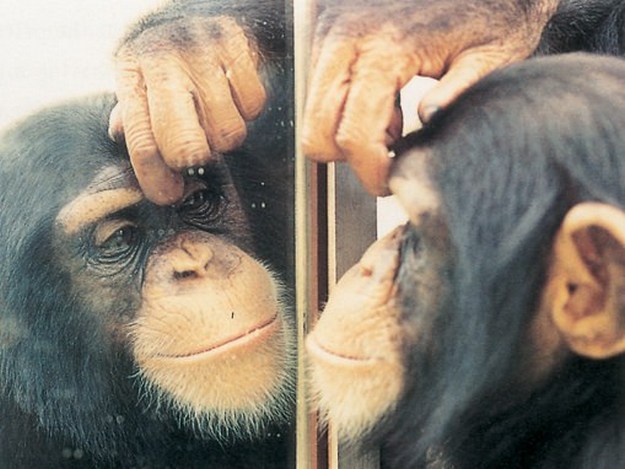
Animals without self-awareness fail the mirror test: they seem to think the reflection is another animal and draw no correlation between the reflected movements, facial expressions, or the telltale mark with their own being.
However, there are some caveats to the mirror test. Despite their intelligence, almost all gorillas fail the mirror test because it's in their nature to avoid eye contact with other gorillas (this is an aggressive gesture in their world). As a result, they don't examine their reflection sufficiently to achieve any kind of self-recognition. One exceptional gorilla who did pass the mark test was Koko the gorilla (see below).
It's also worth noting that animals who previously failed the mirror test have begun to pass it under specific circumstances, such as rhesus macaques (see below). Researchers continue to seek more reliable methods to identify more animals with self-awareness in the future.
10 Animals with Self-Awareness
Let's start with humans and how we develop self-awareness in early childhood, before we examine how key species of mammals and birds have also developed this reasoning ability.
"Perhaps consciousness arises when the brain's simulation of the world becomes so complex that it must include a model of itself." - Richard Dawkins, The Selfish Gene
1. Humans
Humans have self-awareness from infancy, and are able to pass the mirror test from around 18 months old. Closer inspection of this phenomenon has identified five distinct levels of self-awareness in children before they reach 4-5 years old:
- Level 0: Confusion - Level zero relates to non-human animals like canaries, who are oblivious to the mirror as a source of reflection. Instead, they appear to accept it as an extension of their world; it's quite common that the sight of a "fellow" canary in the mirror triggers songs of courtship.
- Level 1: Differentiation - Studies show that 24-hour-old infants root significantly more to external stimulus versus their own touch. Contrary to many classic theories, babies are not born in a state of confusion with the environment; they do show some self–world differentiation. In the mirror test, this is demonstrated by recognizing that the imagery in the mirror is somehow different from the environment that surrounds it.
- Level 2: Situation - By two months old, babies explore the link between observed movements in the mirror and their own body's movements. One remarkable experiment showed six-week old babies systematically copying the direction in which an adult poked out their tongue, revealing an aptitude for mapping their own bodily space and that of the adult model.
- Level 3: Identification - Accomplished in multiple sub-stages by 14-18 months, infants recognize their own face in the mirror. This is a major feat: for the first time, they acknowledge their own appearance "en face" with eye contact, which is how others see them.
- Level 4: Permanence - At three years old, children begin to recognize the enduring self beyond the mirror experience. They understand that the mirror-self can also be seen in a photo taken yesterday, and that this is still them but in a different time and space.
- Level 5: Self-consciousness - Also known as meta self-awareness, the final development manifests as an awareness of how we are perceived and valued by others. We imagine how others judge us as they encounter our self and these fantasies feed the self-conscious mind. Our level of self-consciousness oscillates hourly: whether we are reading, running, meditating, falling asleep, dreaming, or lucid dreaming.
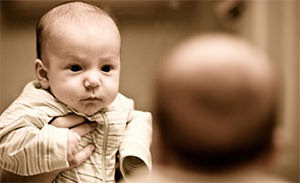
2. Orangutans
Like all the great apes, orangutans are classified as animals with self-awareness. Indeed, it was a captive orangutan who indirectly inspired the mirror test.
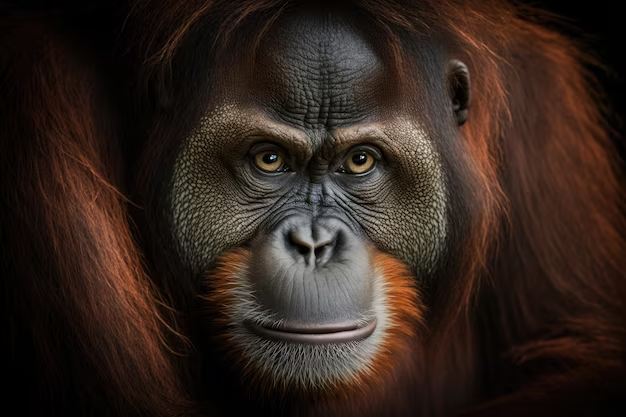
In 1838, when the naturalist Charles Darwin was visiting London Zoo, he watched a female orangutan named Jenny throwing a tantrum after being teased with an apple by her keeper. He began musing on what the subjective experience of being an orangutan must be like. Besides noting how intelligent and human-like Jenny appeared, Darwin also spied her gazing into a mirror and realized she was aware of seeing a reflection of herself.
However, it was 130 years before Gordon Gallup Jr modeled this observation in a 1977 experiment with wild pre-adolescent chimps.
3. Chimpanzees
Gallup's initial subjects, two male and two female chimpanzees, were each put in a room alone for two days. Then a full length mirror was added to the room and their reactions were scrutinized for signs of self-awareness.
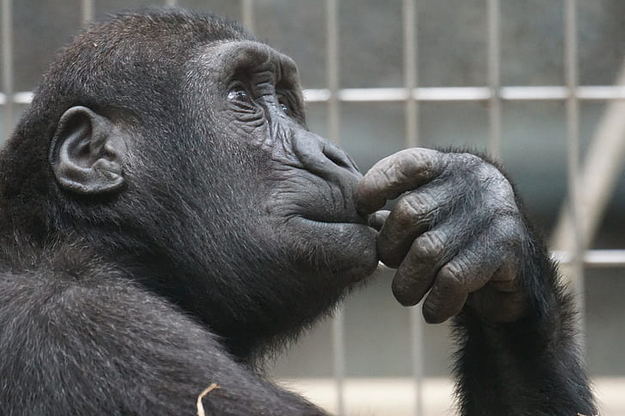
Initially, the chimps (who had never seen a mirror before) made threatening gestures at their reflections. But in time, they began to use the mirror for self-directed responding behaviors, like grooming hard-to-see places, picking their noses, making faces, and blowing bubbles at themselves.
4. Gorillas
Although most gorillas fail the mirror test (thought for lack of eye contact rather than lack of self-awareness), one famous gorilla named Koko has passed the test. Koko was known as the "talking" gorilla, recognizing more than 1,000 words in American Sign Language and 2,000 words in spoken English.
Born in 1971 in San Francisco Zoo, Koko was the subject of a groundbreaking science experiment to determine the true intelligence of gorillas. Although she couldn't vocalize like us, she could still understand spoken words and communicate her thoughts and feelings with hand gestures.
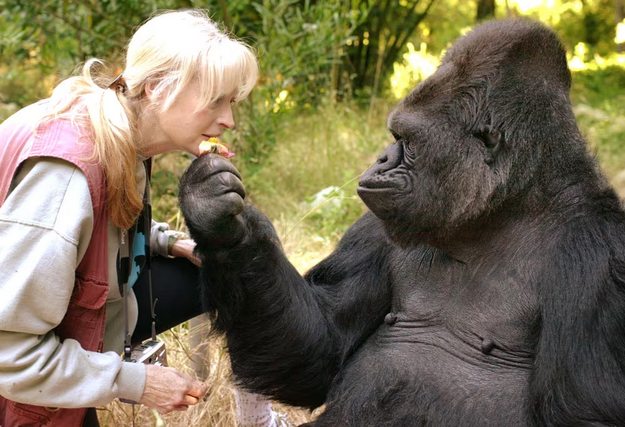
Koko's trainer, Francine Patterson, also saw her invent new signs of her own, like the combination of signs for "finger-bracelet" to describe a ring. In time, Koko even demonstrated that she felt emotions much like humans. For instance, she once asked if she could have a cat and chose out a gray male Manx as her pet, which she cared for as a baby. Sadly, it was not long before the cat escaped and was hit by a car. When Patterson explained the cat was gone forever, Koko signed "bad-sad-bad" and "frown-cry-frown-sad". Koko later picked out two more kittens which became her surrogate babies.
Koko the gorilla passed away at 46 years old in 2018. Having described herself as a "fine-gorilla-person", amazing her friends and caregivers with her intelligence and emotional depth, her astonishing story of self-awareness and compassion for other animals is revealed in several documentaries.
5. Bottlenose Dolphins
Amazingly, marine mammals also have self-awareness, although the experimental set-up has to be tailored a little differently to demonstrate the point. In 2001, two bottlenose dolphins were exposed to reflective surfaces after being marked with black ink. The researchers predicted that the dolphins (who did have previous experience with mirrors) would not show social responses, but rather spend more time in front of the mirror and move closer to inspect themselves.
All the predictions came true; indeed, the dolphins went one step further by consistently selecting the best reflective surfaces to view their new markings.
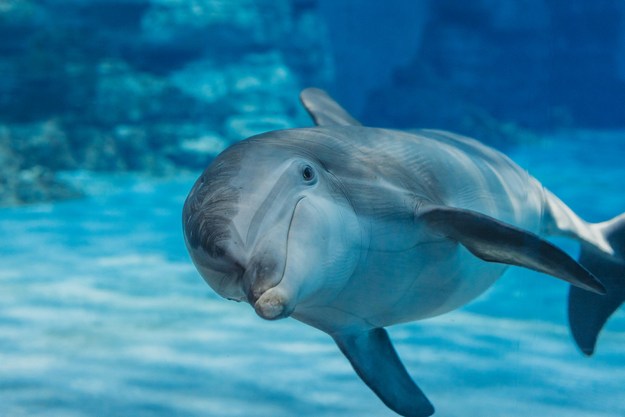
The self-awareness of bottlenose dolphins may be associated with their large brains and advanced cognitive abilities, although not all species of dolphins have such large brains or are known for problem-solving skills. Notably, dolphins and primates evolved separately, suggesting their self-awareness arose independently, a phenomenon they described as cognitive convergence.
6. Elephants
You may be surprised to know that elephants have self-awareness too, as shown in a 2006 study that showed self-recognition in an Asian elephant. The experimenters placed an 8-foot mirror in the elephant enclosure at the Bronx zoo in New York, while researchers kept a close watch over the three inhabitants.
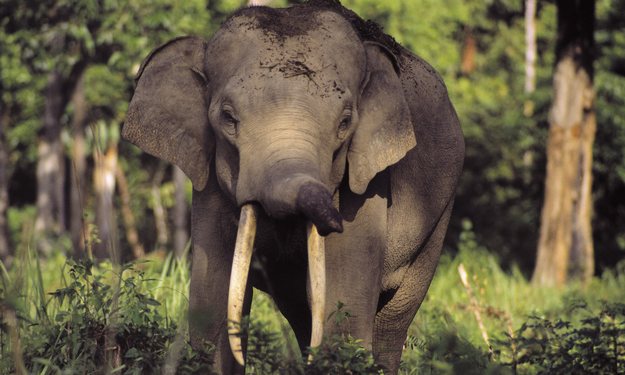
The elephants did not greet their reflections as if they were other elephants, but instead used the mirror to inspect themselves and the inside of their mouths. They also tried to look behind the mirror, which showed they recognized the reflection was not merely an extension of the enclosure. Eventually, one of the elephants passed the colored dot test by touching (with its trunk) a newly painted mark on its head.
Elephants were already known for their superior intelligence, complex social systems, ability to feel empathy, and altruistic behavior. This experiment made them the first non-primate land mammal to pass the mirror test and show true self-awareness.
7. Orcas
Though the details were less publicized in the media, a 2001 experiment published in Behavioural Processes revealed mirror image processing in three marine mammal species including orcas, also known as killer whales.
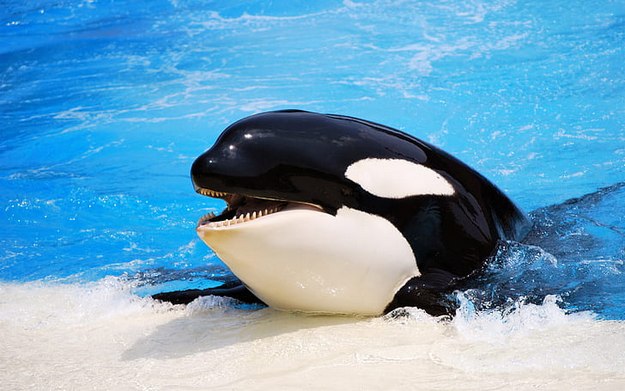
Using the same style of mirror test as with the bottlenose dolphins, the orcas studied did indeed show signs of "contingency checking" in the mirror, reacting to the mark as if they expected their image to look different. Some signs of self-awareness were also seen in false killer whales, and the researches suggested that they appear to possess the cognitive ability for it.
8. Bonobos
Bonobos are an endangered ape species who are known to be more peaceful and social than the common chimpanzee. Genetically, bonobos are most similar to us, sharing common behavioral traits such as walking upright and having similar facial expressions. It's also easier to distinguish facial features between different individual bonobos, such that humans can easily differentiate one bonobo from another.
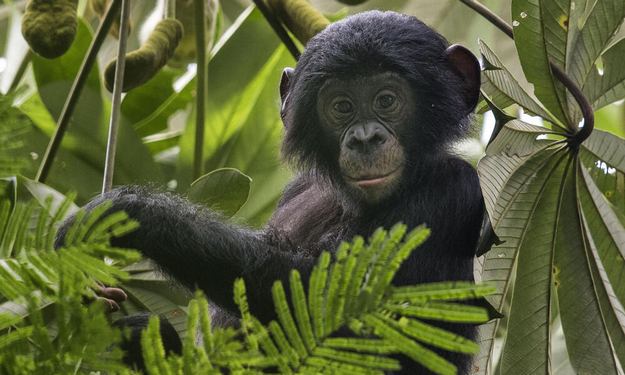
Bonobos first passed the mirror test in 1994. In the 1980s, two sibling bonobos called Kanzi and Panbanisha were taught a vocabulary of about 400 words, which they typed using a keyboard of lexigrams (geometric symbols). They could also respond to spoken sentences.
Quite possibly our most intelligent primate cousins, bonobos are thought to be capable of self-awareness, altruism, compassion, empathy, kindness, patience, and sensitivity. For a fictional take on the study of language in bonobos, check out Sara Gruen's Ape House.
9. Rhesus Macaques
For decades, monkeys failed the mark test for self-awareness, show persistent signs of social responses to mirrors despite prolonged exposure. But in 2010, a team of scientists inadvertently discovered that rhesus macaques can indeed pass the cognitive divide between hominoids and the rest of the animal kingdom.
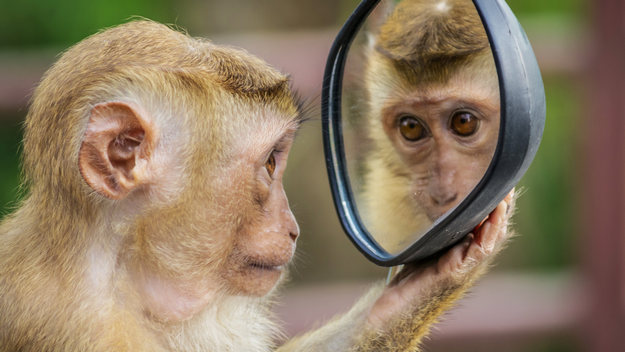
In a study on what was then known as attention deficit disorder (ADD), the researchers placed head implants in two rhesus macaque monkeys. To their surprise, the macaques demonstrated self-awareness by examining their heads near the implant, and later observing themselves in the mirror while grooming.
As they explored their own reflections, the monkeys examined parts of their body that they hadn't seen before, turned themselves upside down to do so, and even adjusted the mirror to get an enhanced view.
10. European Magpies
The final entry on our list of animals with self-awareness is, perhaps startlingly, the European magpie. Not only were magpies the first bird to pass the mirror test, they were also the first non-mammal species, too.
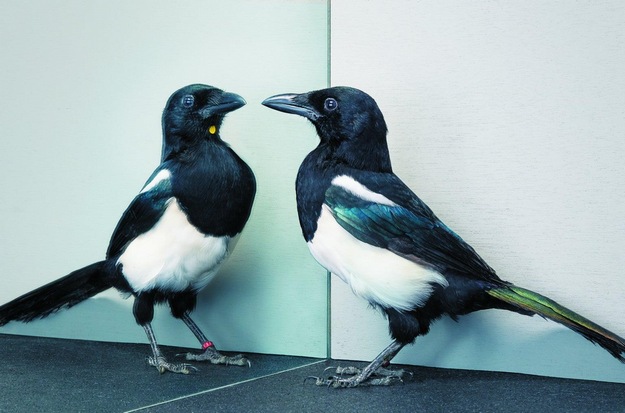
Closely related to crows (who are also known for their intelligence, if not self-awareness) magpies were recognized to have self-awareness in 2008 when researchers placed red, yellow, or black dots on the necks of the birds. While the magpies didn't react to the feel of the dots, they began scratching their necks when placed in front of a mirror. As the control arm, those with black dots (which were camouflaged against their feathers) didn't react at all.
Now here's the rub. It was once thought that self-awareness arises from the neocortex of the brain—but magpies don't have one. The animal behaviorist, Franz de Waal, pointed out that magpies do, nonetheless, have large brains with lots of connectivity:
"Magpies are known for their ability to steal shiny objects and to hide away their loot. It's not too far-fetched that a master thief like a magpie has that perspective-taking ability." - Franz de Waal
Self-Awareness in Lucid Dreams
If self-awareness is a conscious process, how is it possible to arise during lucid dreams when we are technically asleep?
The sleeping brain is not totally dormant, as was once assumed. In typical dreaming, the brain produces electrical activity in the theta, alpha, and beta ranges (4-31 Hertz). But there is usually no self-awareness in dreams, evidenced by the fact that we don't reflect on who we are, what we're doing, or even the fact that we are dreaming.
In lucid dreams, however, we can elicit more brainwave activity, correlating to higher level of consciousness. This results in greater connectivity between brain areas linked with self-reflective functions.
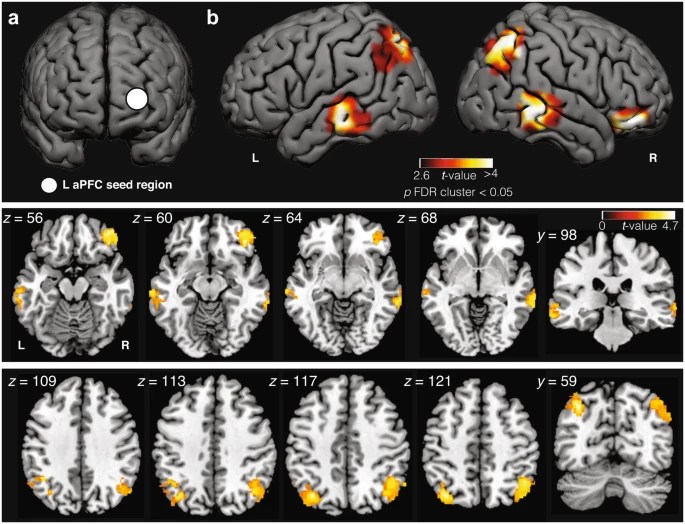
What's more, lucid dreamers have conscious access to their real-world memories during lucid dreaming. Being able to recognize the dream state (an act of spontaneous self-awareness in humans) transforms the regular dream state to a near-waking level of meta-consciousness.
To learn more about gaining self-awareness in dreams, check out our free course on lucid dreaming.
















